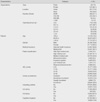Abstract
Purpose
To develop outcome indicators of urinary incontinence to measure quality of care in long term care hospitals in Korea.
Methods
The draft indicators of urinary incontinence were developed from a literature review and clinical expert panel. A survey of medical records of 280 patients in 20 hospitals was conducted to test inter-rater reliability. Statistical analysis was done to test risk adjustment criteria, variation between hospitals, and stability of indicators, using assessment data from 77,918 patients in 623 hospitals.
Results
The inter-rater reliability of items was high (Kappa range: 0.66-0.92). Severe cognitive impairment (odds ratio [OR]: 3.15, confidence interval [CI]: 3.03-3.26) and total mobility activities of daily living (ADLs) dependency (OR: 4.85, CI: 4.72-4.98) increased the prevalence of urinary incontinence, thus they proved to be significant criteria to stratify high and low risk groups. The prevalence for low risk showed more substantial variation than the high risk group. The indicators were stable over one month.
References
1. Arling G, Karon SL, Sainfort F, Zimmerman DR, Ross R. Risk adjustment of nursing home quality indicators. The Gerontologist. 1997. 37:757–766.
2. Arling G, Lewis T, Kane RL, Muller C, Flood S. Improving quality assessment through multi-level modeling: The care of nursing home compare. Health Services Research. 2007. 42:1177–1199.
3. Chung J. Development and application of nursing service quality indicators in nursing homes. Journal of Korean Academy of Nursing. 2007. 37:401–413.
4. Karon SL, Sainfort F, Zimmerman D.R. Stability of nursing home quality indicators over time. Medical Care. 1999. 37:570–579.
5. Lee JY, Yoon JY, Jang SR. A study of validity and reliability of a patient assessment instrument for long-term care hospitals. Journal of Korean Gerontological Nursing. 2008. 10:7–19.
6. Lee JY, Yoon JY, Kim AR, Kim CM. Development of quality management system and indicators of long term care hospitals. 2008. Seoul: Health Insurance Review and Assessment Service.
7. Lee SH. Multi-level analysis of factors related to quality of services in long-term care hospitals. Journal of Korean Academy of Nursing. 2009. 39:409–421.
8. Mainz J. Defining and classifying clinical indicators for quality improvement. International Journal for Quality in Health Care. 2003. 15:523–530.
9. Ministry of Government Legislation. Medical law of Korea. 2009. Retrieved January 13, 2009.
http://www.law.go.kr.
10. Mor V, Berg K, Angelelli J, Gifford D, Morris J, Moore T. The quality of quality measurement in US nursing homes. The Gerontologist. 2003. 43(Special No.2):37–46.
11. Morris JN, Moore T, Jones T, Mor V, Angelelli J, Berg K. Validation of long-term care and post-acute care quality indicators. 2003. Baltimore, MD: U. S. Department of Health and Human Services Center for Medicare and Medicaid.
12. Mukamel DB. Risk-adjusted outcome measure and quality of care in nursing home. Medical Care. 1997. 35:367–395.
13. Mukamel DB, Glance LG, Li Y, Weimer DL, Spector WD, Zinn JS, et al. Does risk adjustment of the CMS quality measures for nursing home matter? Medical Care. 2008. 46:532–541.
14. Mukamel DB, Watson NM, Meng H, Spector WD. Development of a risk-adjusted urinary incontinence outcome measure of quality for nursing homes. Medical Care. 2003. 41:467–478.
15. Ouslander JG, Schnelle JF. Incontinence in the nursing home. Annals of Internal Medicine. 1995. 122:438–449.
16. Rubin HR, Pronovost P, Diette GB. The advantages and disadvantages of process-based measure of health care quality. International Journal for Quality in Health Care. 2001. 13:469–474.
17. Schnelle JF. Managing urinary incontinence in the elderly. 1991. New York, NY: Springer Publishing Company.
18. Zimmerman DR, Karon SL, Arling G, Clark BR, Collins T, Ross R. Development and testing of nursing home quality indicators. Health Care Financing Review. 1995. 16:107–127.




 PDF
PDF ePub
ePub Citation
Citation Print
Print







 XML Download
XML Download